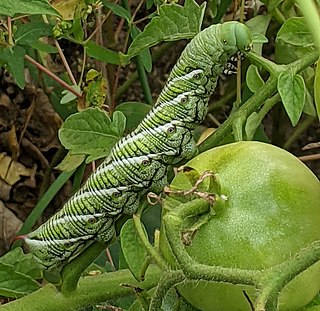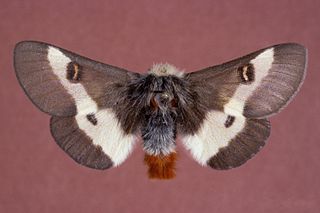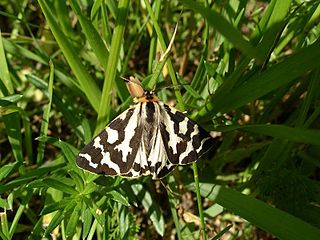
Metamorphosis is a biological process by which an animal physically develops including birth transformation or hatching, involving a conspicuous and relatively abrupt change in the animal's body structure through cell growth and differentiation. Some insects, fish, amphibians, mollusks, crustaceans, cnidarians, echinoderms, and tunicates undergo metamorphosis, which is often accompanied by a change of nutrition source or behavior. Animals can be divided into species that undergo complete metamorphosis ("holometaboly"), incomplete metamorphosis ("hemimetaboly"), or no metamorphosis ("ametaboly").

Caterpillars are the larval stage of members of the order Lepidoptera.
A maternal effect is a situation where the phenotype of an organism is determined not only by the environment it experiences and its genotype, but also by the environment and genotype of its mother. In genetics, maternal effects occur when an organism shows the phenotype expected from the genotype of the mother, irrespective of its own genotype, often due to the mother supplying messenger RNA or proteins to the egg. Maternal effects can also be caused by the maternal environment independent of genotype, sometimes controlling the size, sex, or behaviour of the offspring. These adaptive maternal effects lead to phenotypes of offspring that increase their fitness. Further, it introduces the concept of phenotypic plasticity, an important evolutionary concept. It has been proposed that maternal effects are important for the evolution of adaptive responses to environmental heterogeneity.

Pieris rapae is a small- to medium-sized butterfly species of the whites-and-yellows family Pieridae. It is known in Europe as the small white, in North America as the cabbage white or cabbage butterfly, on several continents as the small cabbage white, and in New Zealand as the white butterfly. The butterfly is recognizable by its white color with small black dots on its wings, and it can be distinguished from P. brassicae by its larger size and the black band at the tip of its forewings.

Manduca sexta is a moth of the family Sphingidae present through much of the Americas. The species was first described by Carl Linnaeus in his 1763 Centuria Insectorum.

The forest tent caterpillar moth is a moth found throughout North America, especially in the eastern regions. Unlike related tent caterpillar species, the larvae of forest tent caterpillars do not make tents, but rather, weave a silky sheet where they lie together during molting. They also lay down strands of silk as they move over branches and travel as groups along these pheromone-containing silk trails. The caterpillars are social, traveling together to feed and massing as a group at rest. Group behavior diminishes as the caterpillars increase in size, so that by the fifth instar (molt) the caterpillars are feeding and resting independently.

A polyphenic trait is a trait for which multiple, discrete phenotypes can arise from a single genotype as a result of differing environmental conditions. It is therefore a special case of phenotypic plasticity.

Phenotypic plasticity refers to some of the changes in an organism's behavior, morphology and physiology in response to a unique environment. Fundamental to the way in which organisms cope with environmental variation, phenotypic plasticity encompasses all types of environmentally induced changes that may or may not be permanent throughout an individual's lifespan.

The buck moth is a common insect found in oak forests, stretching in the United States from peninsular Florida to New England, and as far west as Texas and Kansas. It was first described by Dru Drury in 1773. The larvae typically emerge in a single generation in the spring. The larvae are covered in hollow spines that are attached to a poison sac. The poison can cause symptoms ranging from stinging, itching and burning sensations to nausea. Subspecies Hemileuca maia maia is listed as endangered in the US state of Connecticut.

The garden tiger moth or great tiger moth is a moth of the family Erebidae. Arctia caja is a northern species found in the US, Canada, and Europe. The moth prefers cold climates with temperate seasonality, as the larvae overwinter, and preferentially chooses host plants that produce pyrrolizidine alkaloids. However, garden tiger moths are generalists, and will pick many different plants to use as larval host plants.

The Mediterranean flour moth or mill moth is a moth of the family Pyralidae. It is a common pest of cereal grains, especially flour. This moth is found throughout the world, especially in countries with temperate climates. It prefers warm temperatures for more rapid development, but it can survive a wide range of temperatures.

Scathophaga stercoraria, commonly known as the yellow dung fly or the golden dung fly, is one of the most familiar and abundant flies in many parts of the Northern Hemisphere. As its common name suggests, it is often found on the feces of large mammals, such as horses, cattle, sheep, deer, and wild boar, where it goes to breed. The distribution of S. stercoraria is likely influenced by human agriculture, especially in northern Europe and North America. The Scathophaga are integral in the animal kingdom due to their role in the natural decomposition of dung in fields. They are also very important in the scientific world due to their short life cycles and susceptibility to experimental manipulations; thus, they have contributed significant knowledge about animal behavior.

Biston strataria, the oak beauty, is a moth of the family Geometridae. It is native to Europe, the Balkan countries and the Black Sea region as far as Asia Minor and the Caucasus. The species was first described by Johann Siegfried Hufnagel in 1767. B. strataria is found in a variety of habitats, but is mostly found in woodlands where it rests on the bark of trees, camouflaged by its mottled black and grey wings. The male has feather-like antennae while those of the female are more thread-like. The moth has a wingspan of 40 to 56 mm.

Arctia plantaginis, the wood tiger, is a moth of the family Erebidae. Several subspecies are found in the Holarctic ecozone south to Anatolia, Transcaucasus, northern Iran, Kazakhstan, Mongolia, China, Korea and Japan. One subspecies is endemic to North America.

Eriogaster lanestris, commonly known as the small eggar, is a moth of the family Lasiocampidae that is found across the Palearctic. Unlike many other members of the Lasiocampidae, the small eggar is a social insect. Historically, only eusocial insects like ants, bees, and termites were thought to exhibit complex social organization and communication systems. However, research since the late 20th century has found that E. lanestris, among a number of other phylogenetically related moth and butterfly species, demonstrates social behaviors as well. Larvae spend nearly their entire development in colonies of about 200 individuals, and this grouped social structure offers a number of benefits, from thermoregulation to increased foraging success.

Gynaephora groenlandica, the Arctic woolly bear moth, is an erebid moth native to the High Arctic in the Canadian archipelago, Greenland and Wrangel Island in Russia. It is known for its slow rate of development, as its full caterpillar life cycle may extend up to 7 years, with moulting occurring each spring. This species remains in a larval state for the vast majority of its life. Rare among Lepidoptera, it undergoes an annual period of diapause that lasts for much of the calendar year, as G. groenlandica is subject to some of the longest, most extreme winters on Earth. In this dormant state, it can withstand temperatures as low as −70 °C. The Arctic woolly bear moth also exhibits basking behavior, which aids in temperature regulation and digestion and affects both metabolism and oxygen consumption. Females generally do not fly, while males usually do.

Bicyclus anynana is a small brown butterfly in the family Nymphalidae, the most globally diverse family of butterflies. It is primarily found in eastern Africa from southern Sudan to Eswatini. It is found mostly in woodland areas and flies close to the ground. Male wingspans are 35–40 mm and female wingspans are 45–49 mm.
Insects have a wide variety of predators, including birds, reptiles, amphibians, mammals, carnivorous plants, and other arthropods. The great majority (80–99.99%) of individuals born do not survive to reproductive age, with perhaps 50% of this mortality rate attributed to predation. In order to deal with this ongoing escapist battle, insects have evolved a wide range of defense mechanisms. The only restraint on these adaptations is that their cost, in terms of time and energy, does not exceed the benefit that they provide to the organism. The further that a feature tips the balance towards beneficial, the more likely that selection will act upon the trait, passing it down to further generations. The opposite also holds true; defenses that are too costly will have a little chance of being passed down. Examples of defenses that have withstood the test of time include hiding, escape by flight or running, and firmly holding ground to fight as well as producing chemicals and social structures that help prevent predation.

Samea multiplicalis, the salvinia stem-borer moth, is an aquatic moth commonly found in freshwater habitats from the southern United States to Argentina, as well as in Australia where it was introduced in 1981. Salvinia stem-borer moths lay their eggs on water plants like Azolla caroliniana, Pistia stratiotes, and Salvinia rotundifolia. Larval feeding on host plants causes plant death, which makes S. multiplicalis a good candidate for biological control of weedy water plants like Salvinia molesta, an invasive water fern in Australia. However, high rates of parasitism in the moth compromise its ability to effectively control water weeds. S. multiplicalis larvae are a pale yellow to green color, and adults develop tan coloration with darker patterning. The lifespan, from egg to the end of adulthood is typically three to four weeks. The species was first described by Achille Guenée in 1854.

Hemileuca lucina, the New England buck moth, is a species of moth in the family Saturniidae. This moth species is only found in the New England region of the United States. Larvae in early stages mainly feed on broadleaf meadowsweet whereas larvae in later stages show variation in food sources such as blackberry and black cherry leaves. Larvae have a black body with orange/black spines on their back that are used to deter predators. Pupation occurs during the summer and adult moths come out around September.


















